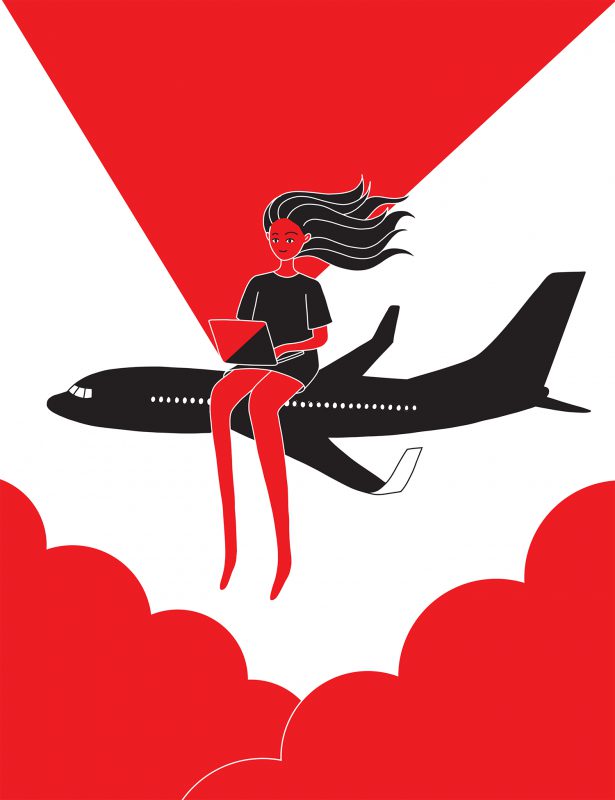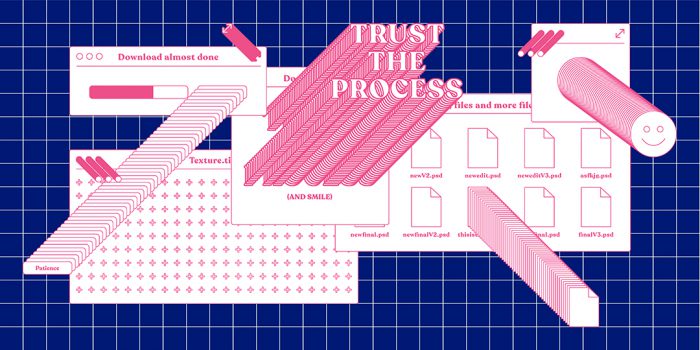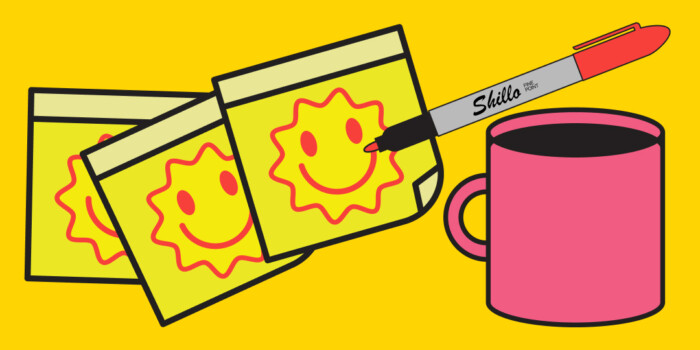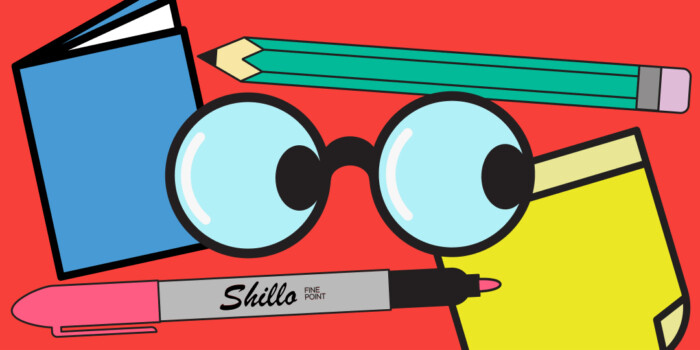How to Get & Impress International Graphic Design Clients (6 Helpful Tips)

Illustration by Lorik Khodaverdian, Shillington Graduate
For Shillington Post 07—The International Issue, we asked our Shillington community from around the world to talk about their experiences working with international clients and to share some tips for others looking to broaden their experience. Read on to hear from our graduates Margherita Baldi, Oceane Combeau, Chukwudi Ogbonnaya, Nataly Lee, Camila Rogelis, Anastasiia Vinnichenko and teachers Spencer Harrison, Adam Busby, Saxon Campbell, Jimmy Muldoon and Robin Cameron.
Have you considered working abroad or taking on a project for an international client? Working in another city allows you to leave your comfort zone and embrace a new culture. Similarly, working remotely from home for an international client can be a great learning experience and challenge you creatively.
Get social and get connected
Use social media and design sites to broaden your global reach
A good place to start is by connecting with other creatives, no matter where you’re based. The multitude of online design sites makes it easier than ever to build new relationships with other people globally by following their design work and commenting on projects. By appreciating other creatives online, you can make your presence known.
Behance is one of the best online communities for connecting with other designers, staying current on what studios are doing and following design trends. And in addition to finding inspiration, Margherita Baldi (Manchester Graduate) recommends using Behance to find resources like mockups and typefaces. Saxon Campbell (New York Part-Time Teacher) uses Behance to post his professional and personal projects he likes working on and to stay on top of what’s happening in the world of design. For the past three and a half years, he’s had a lot of success on this platform for finding local and international clients.
Instagram is the prime connector for establishing a dialogue with designers whose work you admire and a way to be a more active participant in the global design community. Jimmy Muldoon (New York full-time Teacher) uses the direct message aka “DM” function to contact designers to comment on their work, ask questions or to arrange an in person meetup. You never know what can come from a new connection! Through your network, you can find unexpected opportunities, but the most important thing, he adds, is to “establish genuine relationships around a common passion—the work that comes from the connection is just an added bonus.” For work-in-progress design work that he’s exploring, he likes to post to his Instagram feed and stories for both exposure and feedback.
Social networks are ideal for finding international clients. Spencer Harrison (Melbourne Part-Time Teacher) says that “many clients are becoming more comfortable with working remotely and will often search online for designers on sites like Behance, Instagram and other platforms,” so make sure to keep your online presence up to date. Just like Jimmy, Spencer agrees that Instagram is a great tool to develop new connections with people that you admire and want to learn from.
Chukwudi Ogbonnaya (New York Graduate) is originally from Nigeria and currently living in New York, working with remote clients in Nigeria, United Kingdom and South Africa. He encourages designers to challenge themselves by staying productive and drawing up a plan on how they will showcase their work and skills. To broaden his exposure as a designer, he signed up with a Pro Dribbble account and makes sure to attend meetups to meet other designers locally. Just like Behance, Dribbble is a platform that can be used for inspiration, a place to receive feedback on your projects, and also for finding job opportunities.
Besides looking at creative communities mentioned, Facebook, Twitter and Linkedin can be an overlooked resource. On Facebook, you can join entrepreneur or small business groups to see who may be hiring for a project. Running Facebook ads for promoting your design services or latest projects can be a part of your client acquisition strategy. Twitter can be used as a way to exchange in a dialogue with other designers/studio—asking questions, sharing industry knowledge, and posting your latest work—since you never know who may retweet your project. Finally, you can use LinkedIn as a place for connecting with other creatives. Comment on posts, join groups and follow companies you like. Potential clients are everywhere!
Open your mind and see what’s out there
Make job boards and recruiters work for you
Have a dream city in mind? Start out by finding a company with offices in countries you are interested in. Companies hire international designers for a fresh cultural perspective and visual approach.
For an aspiring expat, you can join creative site Working Not Working or start your job search on Jobbatical, Coroflot, Krop, Guru, Upwork or Freelancer.
Don’t feel like you’re in this alone! Recruiters from creative agencies can also help with the job search by recommending you to companies that match your skill set. By maintaining a relationship with a few recruiters and periodically checking-in, you can ensure you’re staying updated on new opportunities that can be a good match based on your experience.
When Oceane Combeau (New York Graduate) moved to Amsterdam, she started her own studio, Fernand et Firmin. As she acquired new clients, she was able to get more projects over time. Reflecting on the experience, if she had to do things differently, she advises designers to contact recruiters directly to lend their expertise and to help you find work. If considering moving abroad, she also encourages designers to first build strong relationships with clients in their home country and then continuing working with them while living abroad.
Quit hiding behind your screen
Make meaningful connections through face-to-face networking
Don’t forget the value of face-to-face networking. Get yourself out there! Give yourself a set period of time to network and take advantage of all the different events your city has to offer. Meeting others in person, going to local design events and meetups can help you find new and unexpected opportunities. And who knows? These could help you connect the dots to jobs and possibilities abroad. Global design organisations like Creative Mornings and The Design Kids host regular meetups and have design events in cities around the world.
Margherita takes advantage of the creative scene in Manchester. By attending local design events she was able to make connections with other designers for collaborations. “My advice is to go out, anywhere, and meet people, you never know who you’re going to meet.” She adds that “your website and social media are a great way to showcase your work and also to get clients, but the competition is a lot harder. Being recommended by someone you know personally has more impact!”
For Chukwudi, networking is important in order to get your skills seen by the right people. Also, since working alone can be so isolating, he recommends that other freelancers should find their own work/life balance—taking personal time and finding ways to decompress.
Robin Cameron (New York Part-Time Teacher) relies on personal connections for most of her freelance work. She says, “I tend to work within my networks to tell people what I do and mostly it’s recommendations from friends, partners, and people I have some connection to.” And although this may be a less traditional route, she even had some success with Craigslist.
Being a freelancer can feel isolating at times, therefore, having a workspace outside your home can be a good option for a change of scene.
Coworking spaces are on the rise and can be used as not only your temporary office space, but a place for collaboration and exchanging ideas with other professionals from different industries.
Wow your clients, no matter the distance
Build trust through open communication and exceed client expectations
After you’ve landed a new client, it’s important to know the best practices for maintaining that relationship and finding the most efficient way to manage your project workflow.
As a designer, it’s important to be a strong communicator. For Margherita, most of her work came through word of mouth, friends and their connections in all the three cities where she’s lived—Florence, Berlin, and Manchester. The six degrees of separation theory is truly real!
“Always be nice to people. Maintaining good relationships is the most important thing in business and this is never truer than when freelancing. Most of your work will come from recommendations so if you are an easy person to work with then you are more likely to get the work.”—Nataly Lee (Sydney Graduate). When first starting out as a designer, Saxon suggests to say yes to most projects, and to always make sure you have a contract, as well as over-delivering to exceed client expectations.
Try to go above and beyond on client projects. Adam Busby (Brisbane Part-Time Teacher) believes that “building trust is a big one but achieved through all the small little things that you can easily overlook, such as favouring face to face Skype or Zoom meetings instead of just email alone.” He works around his client’s schedule to ensure that everything will get accomplished on time regardless of location.
Working as a freelancer, Camila Rogelis (London Graduate) typically uses Skype or WhatsApp for meetings. Her approach to design is to focus on the creative process and understanding client needs. She prioritises her projects by tackling the biggest tasks first (such as the conceptual work or layouts) and finishes off with the assignments that require small changes. At the end of the day, she reviews her output and makes a plan for the day ahead.
Chukwudi says that remote work opens up many global opportunities for a designer.
When meeting with a client for the first time, he has a video conference with the team to make a personal connection and to ensure everyone feels at ease. He believes it’s essential to have a solid process in place with working on projects—understanding the brief, capturing as much information at the start of the project and exploring various creative possibilities. For international payments, he says Payoneer is a good option since it’s global and has great conversion rates, providing an easy online money transfer service.
Spencer uses online timezone calculators to determine the best meeting times and after the initial meeting, he says “I’ll normally communicate over email, using Dropbox to send large files to my clients. I also like to present my initial concepts to clients over Skype as it helps to gauge their reactions and asking follow-up questions on any feedback before getting stuck into revisions.”
When Nataly started her business in Cambodia after graduating from Shillington, she chose Phnom Penh as her destination for the thriving creative and international scene. Her small design studio, Saat, focuses primarily on hospitality and tourism brands and she only takes on projects she deeply cares about. She says that her “main goal is to work on projects that are meaningful. I’ve always believed that if you care about your clients, then the work that you create for them will always be good…because it’s not about counting the numbers or ticking off boxes, but it’s about going above and beyond to create something that resonates with you both…and when you do that, the work doesn’t really feel like work. It feels more like a passion project.”
From familiar uncertainty to mind-blowing possibility
Build a career in a new country
Since design work is in high demand, you should look beyond your immediate place of residence and make connections everywhere. Nataly encourages other designers to take the chance and move abroad or to reach out to international companies who might be looking to hire.
When Anastasiia Vinnichenko (Manchester full-time Graduate) left her job in Moscow and moved to Manchester with her husband, she felt this was the perfect time to take the plunge and finally change her career to work in a creative industry. After graduating from the Shillington course, she found a job at a design studio called Tile Creative, which gave her the opportunity to work on projects ranging from print to digital.
Anastasiia recognises that building a career in a new country can be very challenging due to the cultural differences, a new language, and industry.
Coming from a different cultural background can be a unique selling point when looking for work since you will have a different perspective on solving problems and adding value to the team.
She recommends researching local design events where you can learn about the industry trends, meet like-minded people and practice your networking skills. Her advice is to go for it if you are considering working abroad because the experience will be “priceless for both life and work and an opportunity to build your international network.”
Back yourself and stand out from the crowd
Gain exposure through design competitions
Camila has been freelancing with international clients for almost two years in Bogota and loves being a digital nomad—giving her the freedom to work while travelling. She believes that design is a global career that allows you to work anywhere in the world, and make new connections that can turn into work opportunities.
She was able to find the majority of her clients through design competitions which was the principal reason she became a freelancer. She got her first design gig after being in The Rookies People’s Choice category. From there, she was offered a contract for a Sports Management company based in Europe, Africa, and South America to redesign and code their website. When she was hired for this project, she had to take a coding course to upskill and enlisted the help of a friend in the process.
Four months after submitting her work to the Adobe Design Achievement Awards, she received an email from an agency that saw her portfolio in the competition, which then led to work for both UNICEF and United Nations! Camila knows she would never have met these clients if it weren’t for the exposure gained from these competitions. Keep your eyes open for competitions to submit to and get your projects featured on blogs to ensure your work gets seen!
So, what’s stopping you now? There’s no roadmap to success, but these tips will set you on the right track. We hope that if you have been considering taking the leap to move to a different country or working remotely for an international client—that now you can consider it as a real possibility.
Hope you enjoyed these insights from our graduates and teachers about taking the leap into an international design career. If the flexibility to expand your travel horizons while working in a overseas excites you, you should consider studying graphic design! Learn more about becoming a graphic designer in only 3 months full-time or 9 months part-time at Shillington in New York, London, Manchester, Sydney, Melbourne, Brisbane or Online!
Want to win some amazing prizes and stay in the loop with all things Shillington? Sign up to our newsletter to automatically go in the draw.







